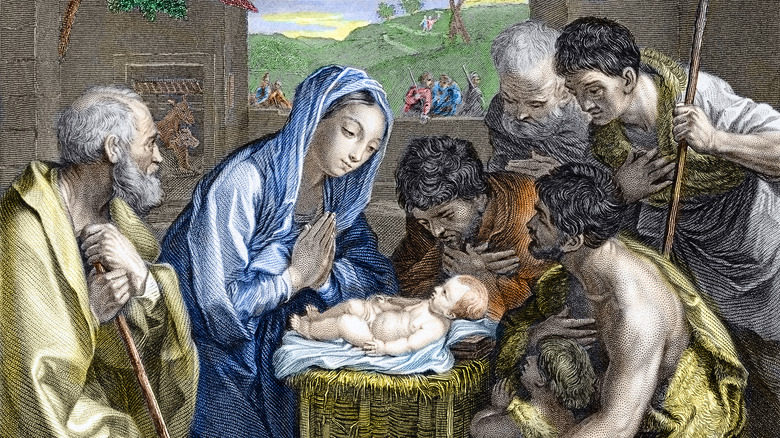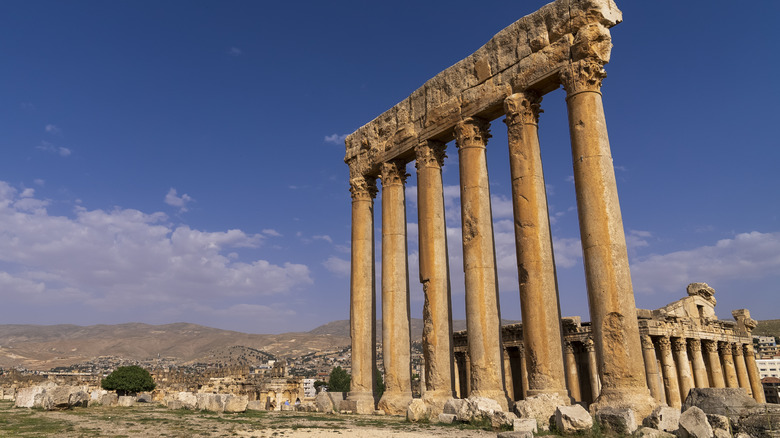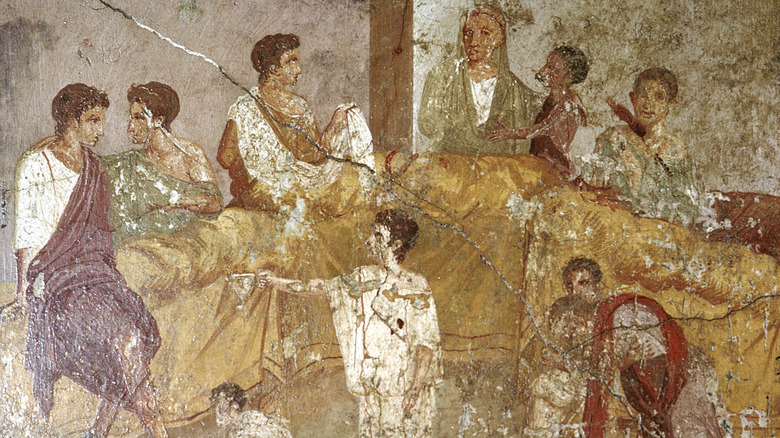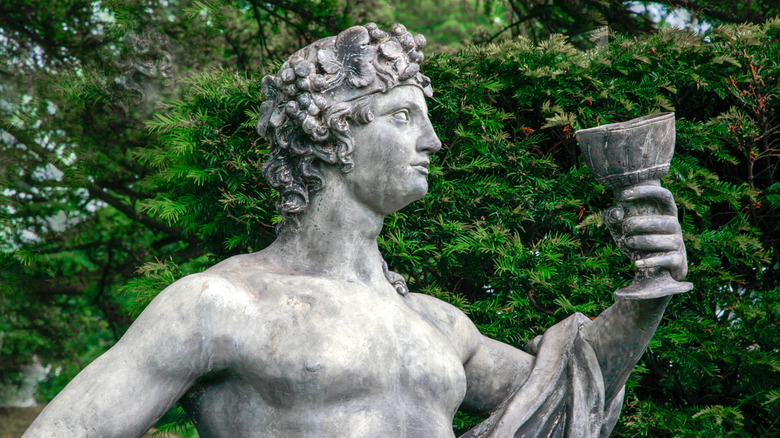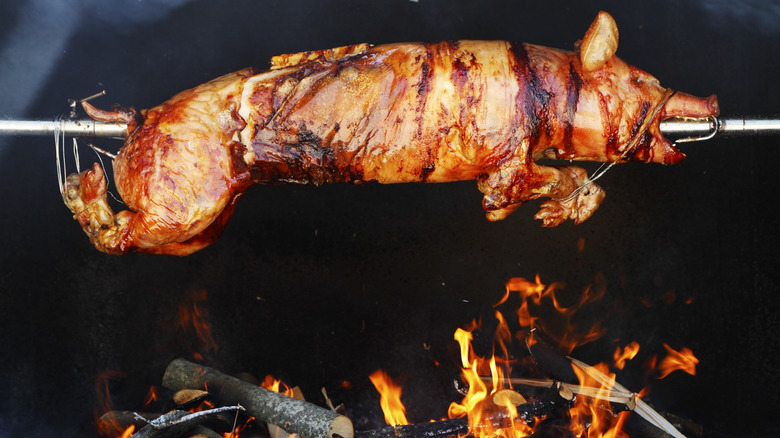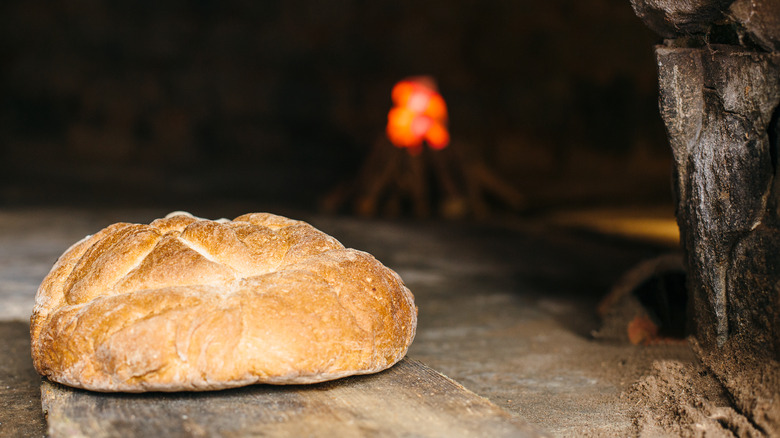What It Was Like To Eat At The First Christmas Feast
What counts as the first Christmas? Of course, some devout Christians would answer that it was the actual day Jesus was born, but if you take Christmas to mean the celebration of Jesus entering the world, it's surprisingly hard to say when it happened or what it looked like. In the first century or two after Jesus' death, there is no record of Christians feasting on his birthday. In fact, some early Christian writers viewed birthdays as sinful or associated them with pagan celebrations.
Beyond the initial Christian opposition to the concept of birthdays, there's also the issue that the bible does not say what time of year Jesus was born. The assignment of December 25 as his date of birth and the holiday's ascension to importance in the Christian ritual calendar was a long, slow process.
Despite the inherent unknowability of the first Christmas, we've taken a crack at reconstructing what it was like to eat at an early Christmas feast, based on prevailing theories about the Roman origin of the celebration. We know a lot about what the ancient Romans ate during their December holidays, and many historians believe that early Christmases took traditions from pre-Christian pagan festivals that involved much merriment, rich food, and heavy drinking.
It may not have happened on December 25
The first recorded guess about Jesus's birthday, from Egypt around 200 A.D., places it in May. Other ancient scholars estimated that Jesus was born in late March, around the time of the spring equinox. A competing theory suggested that Jesus was actually conceived in late March (March 25, to be exact), meaning he would have been born nine months after that, on December 25. While this latter date eventually ended up being when most Christians celebrated Christmas, the disagreement about Jesus' birthday in the first centuries of Christianity meant that the feast celebrating his birth likely happened at different times depending on whatever date local church authorities thought was right.
The December 25 celebration did not become widely adopted until at least the fourth century A.D., and it was first popularized in Europe. Middle Eastern Christians initially celebrated Christmas, Epiphany, and Jesus' baptism all on the same day in early January. Thus, many of the world's earliest Christmas feasts didn't happen on December 25.
The Romans paved the way for modern Western Christmas celebrations
As difficult as it is to point to when or where exactly the first Christmas feast was held, it's fair to say that the forerunner to modern Western Christmas celebrations was in ancient Rome. The feast got its start after Emperor Constantine legalized Christianity in 313. Before this, Christians were persecuted by the Roman Empire, but legalization paved the way for large-scale celebration of Christian holidays.
It's possible that the selection of the December 25th date for Christmas was influenced by pre-existing Roman holidays that occurred around that time. Saturnalia, a week-long festival dedicated to the pagan god Saturn, was celebrated from December 17-23. There was also a feast dedicated to the deity Sol Invictus ("the unconquerable sun" in English) held on December 25. However, there are early sources that predate Christianity being made legal in the Roman Empire that set Jesus' birthday as December 25, so the overlap in date between the Christian and pagan holidays could be a coincidence. It's even possible that the Sol Invictus holiday was promoted as part of a pagan backlash to Christianity and Christmas in Rome.
Either way, we know Saturnalia was a beloved holiday in ancient Rome, and there's no doubt that Roman citizens continued acting out Saturnalia traditions during the winter holidays well into the Christian era. Early Christmas feasts probably resembled raucous Saturnalia celebrations, even if the Christian church would have preferred that the holiday focus on religious observance instead.
The feast disrupted social hierarchies
Saturnalia was the one time of the year when Rome's strict social hierarchies were relaxed and those at the bottom of the ladder could taste the good life. Large public banquets were attended by people from every social class, giving slaves and common laborers a chance to eat fine foods they wouldn't be able to access during the rest of the year. Gift-giving was a big part of the celebration as well, including giving wine and food to enslaved people.
These practices were handed down in mostly intact form in Europe all the way through the 1600s. Well over a millennium after the legalization of Christianity in Rome, British Christmas celebrations often involved wealthy landowners putting on lavish feasts for poor working people. Even more strikingly, people in 17th-century England would sometimes appoint a Lord of Misrule — essentially, a fake king — to act as a sort of master of ceremonies for the drunken debauchery. This, too, was a big part of Saturnalia traditions. The Puritans who took control of England during the 1600s suspected that Christmas was full of Roman influence (they were vehemently anti-Roman Catholic), so they banned the holiday during their brief reign.
There's a good chance there was heavy drinking involved
Beyond its Catholic overtones, Christmas also probably annoyed British Puritans because it featured lots of heavy drinking. Today, we have Christmas gatherings mainly on December 25 (maybe on Christmas Eve, too, if we're lucky), and they're often pretty tame and family-friendly. In contrast, 17th-century British Christmas was a 12-day-long, booze-soaked party. This, too, echoes how Saturnalia (and probably Christmas) was celebrated during the Roman Empire.
Drinking wine was a fundamental part of Saturnalia celebrations. At drinking parties, wine was blended with water in a communal bowl and shared with all attendees — in keeping with the spirit of the holiday, partygoers could be from all social classes. Often, the wine mix was enriched with spices and honey as well; you could say it was the forerunner of the punch bowls featured at modern holiday parties. As British lords did centuries later, members of the upper class in Rome made sure to keep extra wine on hand for the winter festivities.
Pork would have been a central feature for those who could afford it
Today's Christmas dinners often revolve around a ham roast, and early Christmas feasts probably weren't that much different. This is because pork was the most popular meat in the Roman Empire. The pagan rituals around Saturnalia involved well-to-do people buying pigs to sacrifice in honor of the god Saturn — priests and other celebrants would eat the meat from the pigs and the animals' guts were used to tell the future. People would give each other pork sausage and even whole pigs as presents as well.
While Christians wouldn't have anything to do with sacrificing animals in the name of a pagan god, there's no reason why they wouldn't want their Christmas feasts to include pork, especially since it was so ingrained as a celebratory meat in Roman culture. Since Christmas and Saturnalia both encouraged the wealthy to share a bit of their riches with the lower rungs of society, there's a good chance that late December was one of the few times some poorer Romans got to eat large amounts of pork. And, much like we pair ham with pineapple today, Romans liked their pork accompanied by fruit, particularly with dates and apricots.
Bread and vegetables were staples for common people
Even though Christmas and Saturnalia encouraged more social mixing than was customary in Roman society, we think it's safe to say that the festive winter meals enjoyed by the rich were still more luxurious than those eaten by the poor and middle class. As such, if you weren't rich, your Christmas feast probably featured a higher proportion of plant-based foods and dairy. Fresh root vegetables, including beets, carrots, parsnips, and turnips, would have been available in the winter. Other vegetables may have been eaten in preserved or pickled form.
In addition to vegetables, grains, and dairy made up the backbone of the average Roman diet. If you were somewhat financially comfortable, that meant bread and cheese — the poorest people in Roman society would not have been able to buy bread and subsisted on a boiled grain porridge instead. Olive oil, dried beans and legumes, and fruit would have also been a part of many people's meals.
The food was seasoned with fish sauce
Salt is the foundation of pretty much all flavor in the kitchen; without it, recipes just lack a certain oomph. Imagine having to cook an entire Christmas dinner if you couldn't use salt — you probably wouldn't have a very good time.
And yet, this is the situation that Roman cooks found themselves in when it came time to prepare celebratory winter food. At least, they didn't have the solid, powdered salt we're familiar with today. Instead, Saturnalia and early Christmas dishes, like most other Roman food, would have been seasoned with fermented fish sauce. This salty, savory liquid was very similar to modern Southeast Asian fish sauce, so if you want to make an ancient Roman-style Christmas dinner this year, all you need to do is stop by your local Asian market. You can even find recipes for this historic feast — there is a collection of Roman recipes compiled by the writer Apicius that includes dishes from the fourth century A.D., exactly the same era when Romans started celebrating Christmas. Why not try serving Apicius' fish sauce-soaked mussels at your next holiday party and see how your guests react?
Desserts were sweetened with honey
The holiday season is all about dessert — we need plenty of Christmas cookies to make it through winter's long, cold nights. Although the refined cane sugar used in most modern sweets didn't become widespread in Europe until the Middle Ages, ancient Romans ate plenty of desserts during their feasts. Sometimes, desserts were sweetened with fruit-based substances like grape must or raisin wine, but honey was arguably the most popular way to satisfy the Roman sweet tooth.
For examples of how Romans used honey in sweet dishes for special occasions, it's helpful to turn again to Apicius. Some of his recipes are recognizable to modern American dessert lovers — one of his dishes is basically the same as contemporary French toast drizzled with honey. Others, like fresh cheese served in a mixture of honey and salty brine, blend sweet and savory in ways that some present-day palates may find challenging. The Romans seemed to enjoy cheesy desserts; another writer, Cato the Elder, transcribed a recipe for globi, which were donuts or fritters made with a cheese-based dough that was fried, dressed with honey, and finished with a shower of poppy seeds.

